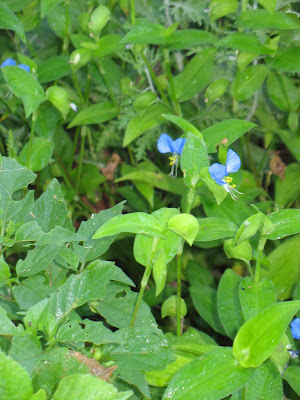But as I was walking to my truck, I happened to look around me and realized I was surrounded by flowers. So here is a sampling of some of the flowers that are on my own property.
The purple cone flower is always a favorite.

But I confess, I have a special place in my heart for the pale yellow cone flower.

The yellow and happy looking coreopsis is always a summer delight.

I was very close to these in the last image and they look huge, don't they? But they are actually a somewhat small flower. Here's a more realistic view.

Can you see the little bumble bee on this waning spiderwort blossom?

Here's some wild purple sage. It is actually very invasive so if you plant this be careful! It really spreads.

This is bee balm. Butterflies love this flower. See the pale yellow coneflower in the background?

Here's another image of bee balm. It is actually a fairly tall flower, though most prairie flowers are usually small and close to the ground.

The Asian daylilly is very common in Iowa. However, what is not common is that it is a plant with vividly blue blossoms. For some reason, blue is a very unusual color in wild flowers.

And see this rather less than attractive plant? It is a thistle that is dying away.

But you know what? Thistle seed is the favorite food of Iowa's state bird -- the gold finch.

Thanks for stopping by and I hope you liked this little tour of some flowers around my place! Oh, Bailey says "hi!" to all of you in Vancouver. I will post some pictures of him soon!
He wants to know if dogs are allowed in such a big city????? He is, after all, a country dog!




7 comments:
Hi...! I am one of Johanna's visitors, and I love seeing these pictures. None of these flowers grow here, and they're really pretty. Believe it or not, we do have gold finches just like that here too, and they come to our Mom and Dad's bird feeder. Oma didn't know that. That's a really good picture! (K)
Bailey sounds like a great dog, and he can come to Vancouver any time he wants. I would like to meet him sometime. (F)
Thank you for your comments! You don't have purple or yellow cone flowers in your area? Interesting.
Bailey says he wants to come to Vancouver but I wish he would learn to drive first. It would make the drive a lot easier if he could share with the driving!
I suggest you and Oma see a movie called Toy Story 3 if you have not already seen it. And another movie you might like is The Young Victoria. I watched it yesterday and had no idea she was so interesting or became Queen so young.
Love coneflowers... we have them along our driveway... they are so hardy and just keep blooming all summer long.
Di
I never knew that was called Asian Daylily, thanks for that. The birds must spread it as it can always move into a wet area where I don't have anything planted. Your wildflower variety is fantastic. Great photos too.
I just love all those flowers--wild or not.
American Gold finch is the State bird of Washington too. Imagine that! MaryBeth
Love your prairie flowers! And that's a good pic of the Gold Finch on the feeder. They're not our state bird, but we see a lot of them here.
Shawn said
What you have marked as an Asian daylily isn't a daylily at all. Daylilies come in a variety of colors and sizes but one thing remains true, they are not a vine. Daylilies range from 16 inches tall to 3+ feet tall and have a single long stem with 3-6 flowers on each stem. I have been raising and cultivating them for 20 years at least. They are and were my favorite wild flower as I grew up, I used to take a few bulbs every time I saw a wild patch of them to plant in my yard. That blue flowering vine in your picture is the bane of my existence. I cannot identify it, nor can I kill it and it is smothering my patch of wild daylilies. I am at the moment lightly spraying it with vinegar and soap trying to kill just it and not my lilies. Would gladly accept help figuring out what that really is and how to kill it.
Post a Comment